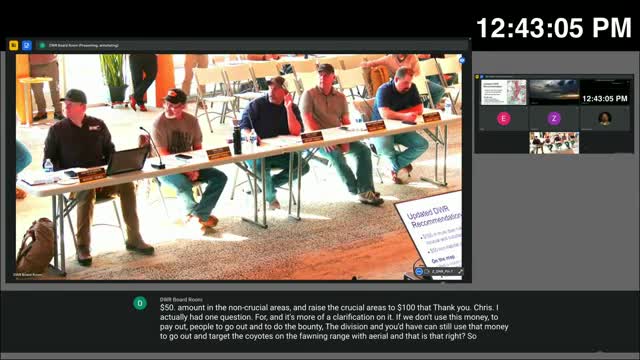Northeast region approves increased coyote bounty to protect mule deer fawns
January 09, 2025 | Utah Department of Natural Resources, Utah Government Divisions, Utah Legislative Branch, Utah
Thanks to Excel Chiropractic and Scribe from Workplace AI , all articles about Utah are free for you to enjoy throughout 2025!

This article was created by AI using a video recording of the meeting. It summarizes the key points discussed, but for full details and context, please refer to the video of the full meeting. Link to Full Meeting
The meeting began with a clarification regarding the funding sources for the coyote bounty program. A total of $250,000 has been earmarked specifically for this initiative, with any unspent funds reverting to the general fund. Additionally, the Utah Department of Agriculture and Food (UDAF) is involved, utilizing a separate pool of money generated from a $5 fee on big game permits.
The Northeast region presented two motions. The first motion proposed increased bounty payments targeting the fawning season for mule deer, suggesting $100 for crucial habitats from December 1 to July 30, $75 for crucial habitats for the remainder of the year, and $50 for non-crucial habitats. This motion passed unanimously. The second motion sought to accept the remainder of the coyote bounty rule as proposed, which also received unanimous support.
In the Central region, a motion was made to accept the division's recommendations and to consider increasing the bounty in targeted areas. This motion passed with a vote of 9 to 1, with the dissenting member expressing concerns about the potential negative perception of bounties on species conservation.
The Northern region proposed amendments to increase the bounty to $100 in critical and substantial mule deer habitat areas, which also passed unanimously. The discussions reflected a general consensus among board members that bounties could be beneficial for wildlife management, particularly in supporting mule deer populations by controlling coyote numbers.
Following the discussions, a motion was made to accept the proposed recommendations regarding the mule deer habitat bounties. The motion received unanimous approval from the board members, indicating strong support for the updated bounty strategy.
In conclusion, the Wildlife Board's meeting underscored a proactive approach to wildlife management in Utah, with a focus on enhancing mule deer populations through targeted coyote bounty programs. The board's decisions reflect a commitment to balancing wildlife conservation with effective management practices. Further actions and follow-ups will be necessary to monitor the outcomes of these initiatives.
Converted from Wildlife Board Meeting 01/9/2025 meeting on January 09, 2025
Link to Full Meeting
Comments
View full meeting
This article is based on a recent meeting—watch the full video and explore the complete transcript for deeper insights into the discussion.
View full meeting
